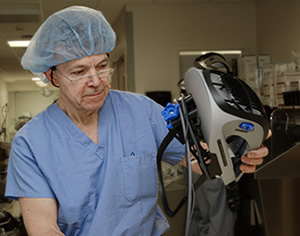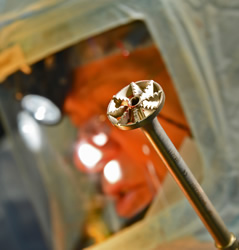Enhancing Patient Outcomes through Anterior Hip Replacement
December 22, 2014

Utilizing advanced operating room equipment, the anterior approach to hip replacement offers patients of St. Luke’s University Health Network important advantages over traditional approaches — advantages including greater long-term stability, reduced pain and accelerated postoperative function.
Since the 1960s, orthopaedic surgeons have employed multiple avenues for performing hip replacements. Until anterior hip replacement became a viable option, surgeons utilizing posterior or lateral approaches had to separate and reattach gluteal muscles from the pelvis and femur to access the joint. In contrast, approaching from the front enables them to make a 9-centimeter incision and avoid muscle detachment. Instead, they gently move muscles out of the way with retractors.
Detaching gluteal muscles is a significant source of postoperative pain, and because of the muscles’ location, common activities can place strain on the operative area, explains William DeLong, MD, Chief of Orthopaedics at St. Luke’s University Health Network and Professor of Orthopaedic Surgery, Anatomy and Cell Biology at Temple University School of Medicine.

“One of the most recurrent things humans do is sit down,” he says. “Because of that, patients have to follow precautions after posterior hip replacement to prevent hip dislocation. When incisions are made in the back, sitting down can make the surgical area vulnerable until the site has healed.”
Even after the immediate postoperative period, the culminating stress of routine activities can strain the operative area and cause serious complications.
“Using traditional replacement methods, patients can go 10–15 years and then experience a dislocation because of stress on the joint from everyday activities, such as sitting down, tying shoes or reaching up to place something on a shelf,” Dr. DeLong says. “This happens because the area traversed during the operation is stressed multiple times per day. When we perform anterior hip replacement, patients’ hips are permanently stable because we don’t release any of the important muscles around the hip.”
Because so few activities require hip flexion, short- or long-term worries about dislocation are virtually eliminated by anterior hip replacement. In addition, the anterior approach benefits patients through faster recovery times, shorter hospitalizations and no postoperative restrictions.
For example, posterior and lateral hip replacement procedures typically require three-day postoperative hospital stays; physical therapy is usually initiated the day after the procedure. Following anterior hip replacement, however, patients often leave the hospital the day after, and physical therapy begins the day of surgery, according to Dr. DeLong.
Positioned for Success
To ensure the highest standards of care, St. Luke’s University Health Network has invested in state-of-the-art operating room equipment for anterior hip replacement.
A specialized hip and knee arthroplasty (HANA) surgical table allows surgeons to precisely position patients in ways that facilitate the procedure. The table’s innovative features work in concert with specially designed curved instruments to enhance surgical proficiency, according to Chandra Reddy, MD, orthopaedic surgeon with St. Luke’s Orthopaedic Specialists.
“After making the incision, you have to go around the femur, which is located deep within the leg,” he notes. “The HANA table has a robotic arm that we use to gently lift the femur for easier access to the joint. Our instruments are specifically designed to maneuver within this space.”
Precise Visualization
When employing posterior or lateral approaches, surgeons must rely solely on their own vision throughout the procedure. But with the HANA table, St. Luke’s University Health Network surgeons have access to real-time fluoroscopic guidance.
“One of the beauties of the anterior approach is live fluoroscopic capabilities throughout the procedure,” Dr. Reddy says. “You can feel the fit and orientation of the implant and then confirm its position on live X-ray.”
This proves particularly valuable during the anatomical tailoring required to fit each patient with an implant. Surgeons select the most appropriate size of implant, then sculpt the anatomy for placement.
“Fitting implants to the anatomy is part of the craftsmanship of joint replacement,” Dr. DeLong says. “Fluoroscopic guidance helps achieve better positioning when you replace the socket. We can ream the old bone and cartilage out to precisely fit the implant. Placing the metal shell in the hip requires precision because if it’s off by even a narrow margin, it can cause instability. When we perform posterior hip replacements, all we have are our eyes for confirmation. Fluoroscopic guidance improves our accuracy.”
An Option for Most

The benefits of anterior hip replacement make it an appealing option for most patients, according to Dr. DeLong. There are no steadfast contraindications, save morbid obesity and exceptional body width.
Dr. DeLong notes that joint replacements should never be performed on obese patients before implementing preoperative strategies to reduce their weight. But even larger people who are not classified as obese can have significant amounts of adipose tissue between the posterior skin and muscle. Anterior hip replacement is an alternative that allows such patients to avoid the greater surgical trauma of posterior or lateral approaches.
Judicious Application
Anterior hip replacement requires expert Orthopaedic surgeons who exercise sound judgment regarding when to operate. In some cases, anti-inflammatory medications, cortisone injections and physical therapy can extend the joint’s life.
“You should not perform a joint replacement surgery one day too soon,” Dr. DeLong says. “I tell patients I can see that they’re candidates for joint replacement on X-rays, but clinically, it has to be a problem for them. They must experience pain that keeps them from enjoying daily activities. When this is the case, anterior hip replacement can restore their quality of life.”
For more information about St. Luke’s University Health Network’s anterior hip replacement capabilities, please visit sluhn.org or call 484-526-1735 or 866-785-8537.
Read More NewsLatest News

December 30, 2025
SLUHN Joins National Study on New Shoulder Replacement Technology


December 09, 2025
